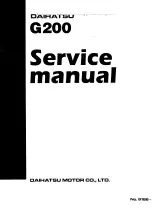
Page 14 of 15
9. Pre-Trip Inspection and Maintenance:
9.1 Inspection:
A walk-around pre-trip inspection/test should be performed every day to verify proper function of the system and to familiarize the operator
with the zones of detection. More frequent inspections should be performed when:
- The vehicle is operating in a particularly dirty or harsh environment.
- The operator has reason to suspect the system has been damaged.
This inspection/test should be performed with two people, one who remains in the cab (the operator), and one who walks through the
sensor detection field (the assistant).
9.2 Maintenance:
1. Clean the sensor face of any accumulation of dirt, mud, snow, ice, or debris.
2. Visually inspect the attached wiring and cable and verify that they are properly secured and not damaged. Inspect the Radar Sensor
and control box and verify that they are securely attached to the vehicle.
3. Set the park brakes, start the vehicle, depress and hold the vehicle brake, and place the vehicle in reverse.
4. The area to the rear of the vehicle should be clear of obstacles for a distance greater than the sensor range. If the monitor shows any
overlay or buzzer sounds, then there are objects to the rear of the vehicle that will interfere with the test. Move the vehicle to a clear
area and proceed.
5. The assistant should move to just behind the rear corner of the vehicle in sight of the operator’s mirrors. They should then walk
toward the center line of the vehicle parallel to the rear, while the operator notes when the monitor shows an overlay and buzzer
sounds, signifying the sensor has detected the object.
6. The assistant should continue walking through the area at the rear of the vehicle while the operator notes the area where detection
occurs.
7. Next, walk from the center of the rear of the vehicle straight back, away from the vehicle. When the buzzer quits sounding or overlay
disappears, the detection limit has been reached.
8. The assistant should walk the complete rear of the vehicle while the operator notes the detection edges of the entire coverage area.
10. Toubleshooting:
The symptoms described below do not necessarily mean a failure within the system. Please check the following items before you initiate
request for repair.
Symptoms
Causes
Solu
�
ons
No reaction from the system while the
gear is switched to reverse.
No reaction on display while there are
obstacles within the detecting area.
No audible alert while there are obstacles
within the detecting area.
Monitor shows “No Sensor Detected”.
No obstacle within the detecting area,
but constant warning occurs.
Make sure the control box is powered and the
trigger input is not connected. Try unplugging the
USB from your laptop and re-plug in.
Cannot configure with USB TO UART
cable.
No power input or no trigger input.
Improper connection of the sensor or
monitor or sensor is adjusted
improperly.
The monitor sound volume is turned
off or set too low.
Improper connection of the sensor or
the sensor is faulty.
The ground is detected.
The control box is not powered or the
trigger input line has power applied to
it.
Check all connections and ensure that unit
is properly grounded and getting proper
voltage. See Section 6.2.
Check all connection and sensor adjustment.
Check the volume level on the monitor.
Also, ensure the speaker is connected
securely to the control box.
Adjust the angle of the sensor and re-push the
configuration through the software tool. Depending on
the environment this vehicle is being used in, it may be
necessary to zero out the green zone.
Check all connections between the control
box and sensor, or replace transmission cable.

































